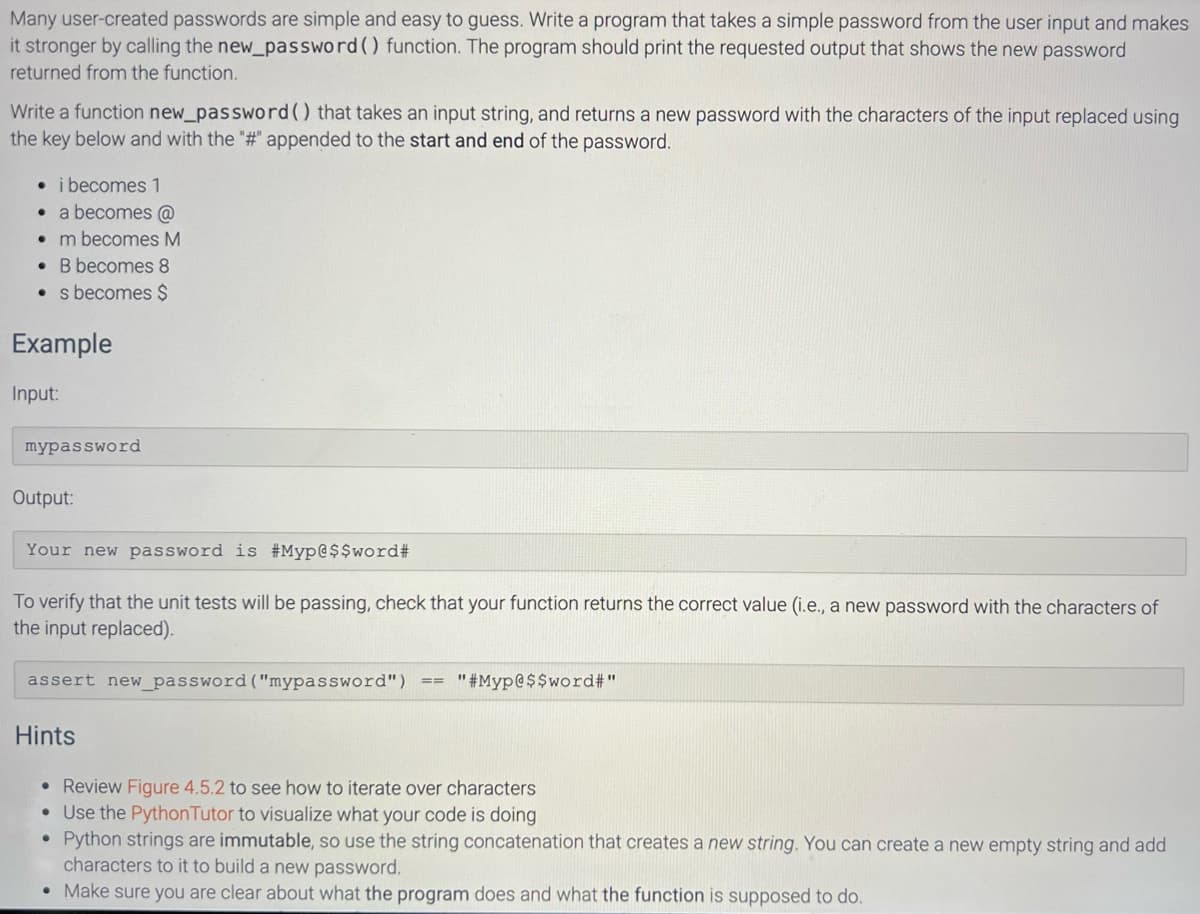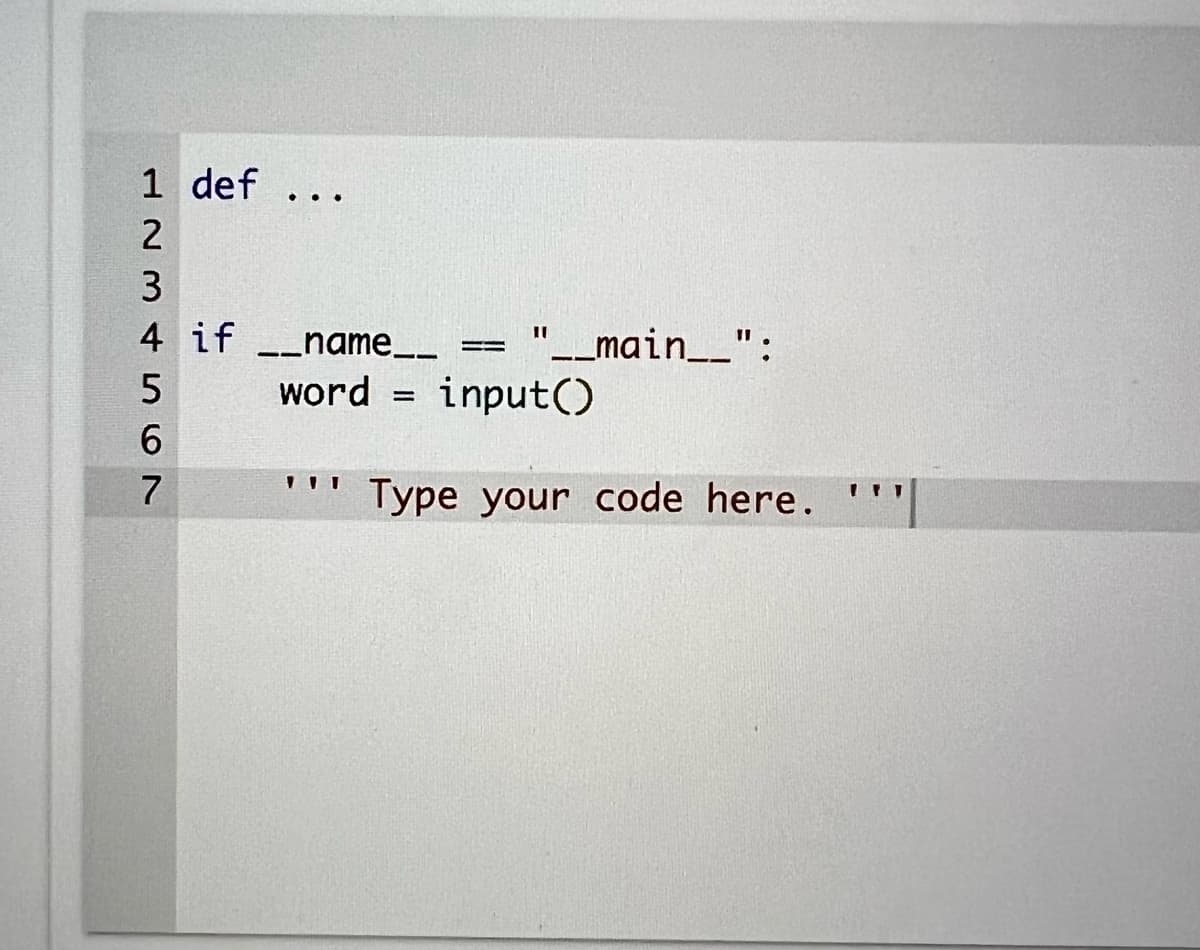Many user-created passwords are simple and easy to guess. Write a program that takes a simple password from the user input and makes it stronger by calling the new_password () function. The program should print the requested output that shows the new password returned from the function. Write a function new_password () that takes an input string, and returns a new password with the characters of the input replaced using the key below and with the "#" appended to the start and end of the password. i becomes 1 • a becomes @ m becomes M B becomes 8 • s becomes $ Example Input: mypassword Output: Your new password is #Myp@$$word# To verify that the unit tests will be passing, check that your function returns the correct value (i.e., a new password with the characters of the input replaced). assert new_password ("mypassword") Hints == ● "#Myp@$$word#" • Review Figure 4.5.2 to see how to iterate over characters • Use the Python Tutor to visualize what your code is doing Python strings are immutable, so use the string concatenation that creates a new string. You can create a new empty string and add characters to it to build a new password. • Make sure you are clear about what the program does and what the function is supposed to do
Many user-created passwords are simple and easy to guess. Write a program that takes a simple password from the user input and makes it stronger by calling the new_password () function. The program should print the requested output that shows the new password returned from the function. Write a function new_password () that takes an input string, and returns a new password with the characters of the input replaced using the key below and with the "#" appended to the start and end of the password. i becomes 1 • a becomes @ m becomes M B becomes 8 • s becomes $ Example Input: mypassword Output: Your new password is #Myp@$$word# To verify that the unit tests will be passing, check that your function returns the correct value (i.e., a new password with the characters of the input replaced). assert new_password ("mypassword") Hints == ● "#Myp@$$word#" • Review Figure 4.5.2 to see how to iterate over characters • Use the Python Tutor to visualize what your code is doing Python strings are immutable, so use the string concatenation that creates a new string. You can create a new empty string and add characters to it to build a new password. • Make sure you are clear about what the program does and what the function is supposed to do
C++ Programming: From Problem Analysis to Program Design
8th Edition
ISBN:9781337102087
Author:D. S. Malik
Publisher:D. S. Malik
Chapter7: User-defined Simple Data Types, Namespaces, And The String Type
Section: Chapter Questions
Problem 8PE: Write a program that reads in a line consisting of a students name, Social Security number, user ID,...
Related questions
Question
Password modifier in python

Transcribed Image Text:Many user-created passwords are simple and easy to guess. Write a program that takes a simple password from the user input and makes
it stronger by calling the new_password () function. The program should print the requested output that shows the new password
returned from the function.
Write a function new_password () that takes an input string, and returns a new password with the characters of the input replaced using
the key below and with the "#" appended to the start and end of the password.
• i becomes 1
• a becomes @
. m becomes M
. B becomes 8
s becomes $
Example
Input:
mypassword
Output:
Your new password is #Myp@$$word#
To verify that the unit tests will be passing, check that your function returns the correct value (i.e., a new password with the characters of
the input replaced).
assert new_password ("mypassword")
Hints
==
"#Myp@$$word#"
• Review Figure 4.5.2 to see how to iterate over characters
• Use the Python Tutor to visualize what your code is doing
●
Python strings are immutable, so use the string concatenation that creates a new string. You can create a new empty string and add
characters to it to build a new password.
• Make sure you are clear about what the program does and what the function is supposed to do.

Transcribed Image Text:1 def...
2
3
4 if __name__
word
567
=
=
11
"__main___":
input()
Type your code here.
Expert Solution
This question has been solved!
Explore an expertly crafted, step-by-step solution for a thorough understanding of key concepts.
This is a popular solution!
Trending now
This is a popular solution!
Step by step
Solved in 4 steps with 2 images

Knowledge Booster
Learn more about
Need a deep-dive on the concept behind this application? Look no further. Learn more about this topic, computer-science and related others by exploring similar questions and additional content below.Recommended textbooks for you

C++ Programming: From Problem Analysis to Program…
Computer Science
ISBN:
9781337102087
Author:
D. S. Malik
Publisher:
Cengage Learning

C++ Programming: From Problem Analysis to Program…
Computer Science
ISBN:
9781337102087
Author:
D. S. Malik
Publisher:
Cengage Learning